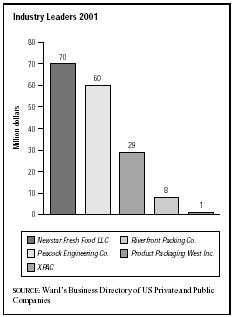SIC 4783
PACKING AND CRATING
This industry includes establishments that derive more than 50 percent of their revenues from packing, crating, and otherwise preparing goods for shipping. Establishments primarily engaged in packaging and labeling merchandise for purposes other than shipping, such as retail packaging, are classified in SIC 7389: Business Services, Not Elsewhere Classified.
NAICS Code(s)
488991 (Packing and Crating)
Approximately 1,205 firms operated 1,246 establishments in this industry in 2001, employing 13,187 workers with an annual payroll of $344.6 million. Most of these were small or medium-sized establishments; only 31 firms employed more than 100 workers.
Most large manufacturers in the United States pack or crate their own goods for shipment rather than relying on the specialty firms in this industry; this industry's services also are offered by many firms primarily engaged in other activities, such as shipping of freight. Firms in the industry typically offer a line of shippingrelated services, such as supplying packing materials, physically packaging goods to the sender's specification, and transporting goods to and from the packaging plant. Some businesses also arrange for the final shipment of goods, either through third-party services or through their own shipping networks, and may offer clients insurance policies on goods shipped and computer tracking of goods. Firms specializing in the shipping aspects, however, are not included in this industry.

Characteristic of the 1990s was the rise in small business start-ups. With them came the reality that many otherwise-successful entrepreneurships could not afford the packaging and crating of their own goods. A niche market was born: the "co-packing" industry. The term was first used in France in 1998, but quickly spread to the United States. Its concept was simple: by out-sourcing the packing end of the business, many small companies could now direct their resources to sales and marketing. By 1999, co-packing was common jargon in smaller businesses, and had been employed in several larger ones, including Land O' Lakes Dairy Foods and Quaker Oats.
In the 2000s, the industry was looking to replace polystyrene packing peanuts with something cost-effective and environmentally friendly. Despite their problems, peanuts were inexpensive, effective at protecting against damage, and simple to use. Therefore, companies continue to use peanuts more than any other type of packaging material—50 million pounds in 2002. Inflatable plastic bags and paper fill were looking to fill the need, but each had its drawbacks. For example, both inflatables and Kraft paper required special equipment, making the initial cash outlay cost-prohibitive for many companies.
The industry leader in 2001 was Newstar Fresh Food LLC of Salinas, California, with $70 million in revenue and 300 employees. Second was Peacock Engineering Co. of Itasca, Illinois, with $60 million in revenue and 300 employees. In third place was Milan, Illinois-based XPAC, with $29 million in revenue and 100 employees. Other notable companies were Riverfront Packing Co. LLC of Vero Beach, Florida, and Product Packaging West Inc., of North Hollywood, California.
Further Reading
"About NewStar." 23 March 2004. Available from http://www.newstarfresh.com .
Baker, Deborah J., ed. Ward's Business Directory of US Private and Public Companies. Detroit, MI: Thomson Gale, 2003.
Siegel, Jeff. "Brand-New Bag." Operations & Fulfillment, 1 September 2003.
U.S. Census Bureau. Statistics of U.S. Businesses: 2001. 1 March 2004. Available from http://www.census.gov/epcd/susb/2001/us/US332311.htm .
"XPAC Overview," 2002. Available from http://www.exportpackaging.com .
Comment about this article, ask questions, or add new information about this topic: